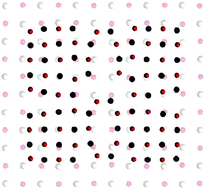Ultrathin oxide films and heterojunctions: CaO layers on BaO and SrO
Abstract
We examine the form of the islands formed by CaO on BaO and SrO substrates using both periodic density functional theory and atomistic simulation techniques. (100) edges dominate the island morphology and we examine how the CaO adjusts to the substrate in small and medium sized islands and at much larger coverages. There is no direct overlay of CaO ion pairs over OBa or OSr pairs in the top substrate layer. Rather, island bond lengths are all much shorter than those even in bulk CaO, even in the interior of the islands, and more similar to those in CaO clusters and isolated thin films. Corner atoms are associated with particularly short Ca–O bond lengths and the low coordination numbers at such positions. The islands show a marked deviation from planarity which can be broadly rationalized in terms of different preferential bond lengths for Ca and O with substrate O and Ba (Sr), respectively. The marked preferences for particular bond lengths lead to the formation of loops or gaps in non-square islands, areas where islands interact and along the mid-edges of large islands. Exchange with the much larger

- This article is part of the themed collection: Physical chemistry of solids - The science behind materials engineering

 Please wait while we load your content...
Please wait while we load your content...